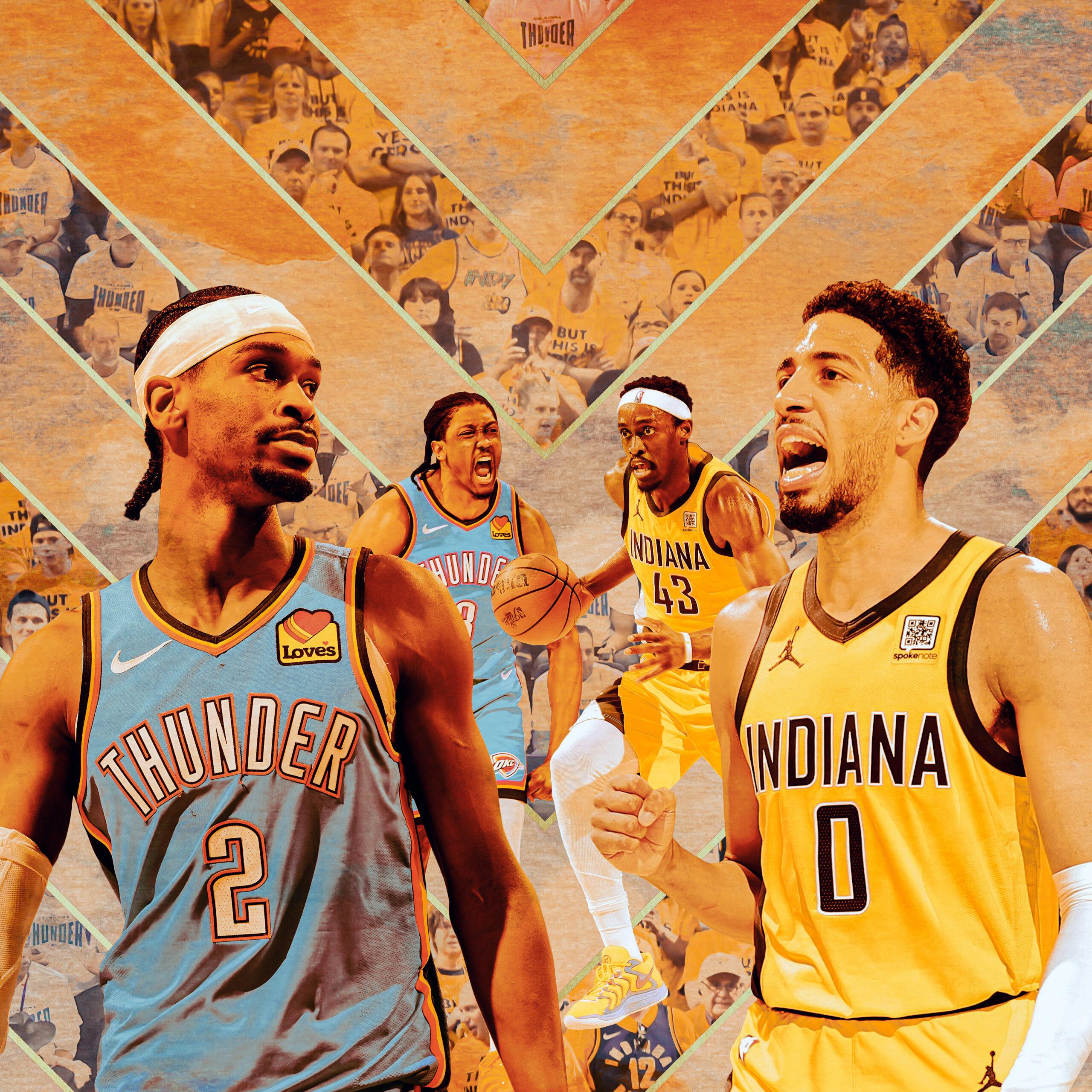
The 2025 NBA Finals are, somehow, tied 2-2 after an instant-classic, whistle-heavy, gut check of a gut punch Game 4 that ended with the Oklahoma City Thunder defeating the Indiana Pacers, 111-104.
It was a night—in the year of our Basketball Lord 2025—that saw the winning team make only three 3-pointers. How? The answer is threefold: fouls, defense, and the glass. For the first time in … a very long time, Indiana’s uptempo offense broke down in the clutch. The Pacers missed all eight of their 3s and scored only 17 points in the fourth quarter. Their last basket was a Tyrese Haliburton floater with 3:20 on the clock.
It was uncharacteristically sluggish offense from a team that’s now generating just 109 points per 100 possessions in the series. The Pacers haven’t been able to run like they normally do. “I’ve gotta do a better job of keeping pace in the game,” Haliburton said afterward. “We were fouling too much, taking the ball out, having to run something instead of random basketball.”
Free throws were the Thunder’s savior (they went 34-for-38 from the line) and the Pacers’ agony (they went 25-for-33, with Bennedict Mathurin missing three in the last 24 seconds of a two-possession game). “They missed four [free throws]. We missed eight. The difference of four is significant,” Rick Carlisle said after the game, which featured the highest combined free-throw rate in these entire playoffs. Moments later, he summed up what might be Indiana’s toughest pill to swallow when it goes back and watches the film for Game 4: “Their second shots were a big problem,” he said. “When you’re unable to rebound, it’s hard to play with pace and tempo.”
Oklahoma City grabbed 10 more boards than Indiana. “This series is going to come down to the basics,” Carlisle said. “Our inability to rebound is the difference.” Chet Holmgren grabbed 15 rebounds himself in what could go down as a legacy-sparking performance on both ends. He protected the paint and held up on the perimeter when Thunder head coach Mark Daigneault changed OKC’s pick-and-roll scheme late and instructed his center to switch ball screens.
“We don’t do that a ton with him because he’s just so impactful at the rim,” Daigneault explained. “But he can really switch. It’s funny, when he was coming out of the draft, that was one of the things that they really recognized with him, is that he's very switchable. He's got great feet. We just found ourselves behind the ball in a lot of plays tonight. The switching was able to get that under control late. We can’t do that unless he can do that. He was outstanding tonight.”
The series moves to a pivotal Game 5 on Monday night in Oklahoma City. Here are three important questions to keep in mind as the series travels South and becomes a best-of-three slugfest that will decide which team gets to be the world champs. “It’s supposed to be hard,” Carlisle said. “This is where we’re going to have to dig in and circle the wagons and come back stronger on Monday. This is a big disappointment, but there’s three games left.”
What Will Oklahoma City’s Rotation Look Like?
Down 2-1 in a series they were heavily favored to dominate, the Thunder returned to the very large and intimidating starting five that helped carry them to the NBA Finals. After playing the first three games with Isaiah Hartenstein off the bench, Daigneault opened Game 4 with a double-big lineup that had only logged 10 minutes, almost exclusively when Indiana had Thomas Bryant on the floor.
It’s hard to find overwhelming statistical evidence to support this change. Cason Wallace with OKC’s other four starters was practical and made enough sense against Indiana’s speed. The newer look with him in the starting five had a plus-13.3 net rating in 36 minutes before Game 4 tipped off. But downsizing can have its limitations, too. One of them is evident: It limits Hartenstein, who is the Thunder’s toughest rebounder and, at times, its shrewdest passer. “It was a point to get Hart more minutes tonight,” Daigneault said afterward when asked about the adjustment. “I thought he's been helpful in his minutes.”
Hartenstein is also Oklahoma City’s most effective screener, able to free up Shai Gilgeous-Alexander and Jalen Williams, find cutters from the high post, and make plays or finish himself out of the short roll. By and large, his combination of physicality and skill gives the Thunder something no one else on the team can. Hartenstein also grabbed three offensive rebounds that immediately led to five Thunder points, which were big.
Plus-minus is a tricky way to evaluate individual games, but there are ways to explain why Hartenstein finished a team-worst minus-7 that may influence whether the Thunder make another change in Game 5. Daigneault’s decision to replace him with Alex Caruso with 4:19 left in the fourth quarter was obvious and necessary. The Pacers had been attacking Hartenstein repeatedly in the pick and roll, forcing help and creating some of their open looks from the corner. He doesn’t exactly improve OKC’s spacing and can’t directly increase their three-point rate (a little more on that later).
Will the Thunder stick with that starting lineup in Game 5, toggle back to Wallace, or risk sticking Caruso out there, knowing he can get in early foul trouble or wear himself out down the stretch?
Daigneault wouldn’t make any lasting commitment after the win. “In terms of the lineup, I mean, we go into every game trying to figure out the formula to win that game. That's what we thought was best to win Game 4 tonight.”
From there, will Kenrich Williams or Aaron Wiggins see more time over Wallace (who played only 19 minutes in Game 4) and Isaiah Joe (who absolutely should not share the court with T.J. McConnell, who’s had quite a bit of success going right at—then by or through—him in this series)? Joe’s minutes will probably dwindle down to zero sooner than later, but Wallace is a tougher call. He’s been a non-factor offensively for the past 10 days, and has yet to hit a 3. On the other end, he’s important for a variety of reasons, but also undersized and prone to getting caught in the occasional crossmatch against Pascal Siakam.
Can Indiana Continue to Make SGA Look Human?
It’s strange to characterize Gilgeous-Alexander’s overall performance in this series as a struggle when you look at his numbers. In Game 4, the MVP scored 35 points, went 10-for-10 from the free-throw line and finished 12-for-24 from the floor. But … he also kinda struggled! It is a massive testament to his greatness, this ability to look relatively awful for nearly 75 percent of a game and then close it with a career-defining performance to save your team’s season. (Jalen Williams assumed OKC’s ball-handling duties early on and was relentless enough to force the issue and keep the game close.)
Continuing a theme from the fourth quarter of Game 3, there were possessions when Gilgeous-Alexander simply didn’t want the ball on Friday night. He was reluctant to fight Andrew Nembhard’s ball pressure and full body denials; if he wasn’t settling for contested, arrhythmic pull-up jumpers from the midrange, he was standing in the corner. It was jarring. He looked mentally and physically fed up with Indiana’s full-court pressure and some of the aggressive pick-and-roll defense that was deployed when he came off a ball screen.
Nembhard knows this dude inside and out. His patterns and timing. Here’s an example from Game 4 that’s signature SGA.
He intentionally takes off while Hartenstein’s screen is still on the way. The purpose is to catch his man off guard and, ideally, get into the paint as a rim protector is exiting it to defend him in the pick-and-roll. Nembhard is more than ready. Even if Mathurin didn’t stunt off the strongside corner, Nembhard would have beaten SGA to the spot and kept him away from the rim, without fouling. He rules.
The best way for Shai to respond? Go against someone else. Down the stretch, SGA and Williams repeatedly worked a two-man game that kept forcing Aaron Nesmith and Nembhard to switch. It worked like a charm right up until Nesmith fouled out of the game: SGA drew a couple shooting fouls, made a very tough and contested stepback after creating separation along the baseline, and sunk the biggest catch-and-shoot 3 of his life:
“I just tried to be aggressive,” SGA said. “I knew what it would have looked like if we lost tonight. I didn't want to go out not swinging. I didn't want to go out not doing everything I could do in my power, in my control to try to win the game. The guys deserve that much from me. The coaching staff deserves that much from me. I just tried to be aggressive, but also let the game come to me, not try to force anything too crazy. I guess it paid off.”
SGA also had zero assists and the Pacers made him defend ball screens all night. Sometimes he switched out on the perimeter and other times he had to battle a larger player (be it Obi Toppin or Siakam) in the paint. Sometimes he won those battles and poked the entry pass away. Other times, he gave up a blow by drive or forced a teammate to help and caused OKC to spring a leak elsewhere.
On one play, when Toppin hit a spot-up corner 3 after Indiana shook loose in transition, Caruso appeared frustrated with Shai for not getting up into Haliburton at the top of the key, which allowed one of the sport’s most eager and precise passers to skip the ball over without anyone up in his face. All those individual mistakes mean less after a win. But it’s still clear SGA is as uncomfortable in these Finals as he’s been all season. In a tied series between two teams that are officially familiar with each other’s tendencies, SGA may have to do what he did down the stretch of Game 4 two more times.
Of course, those shots in the final few minutes would have mattered a lot less if Holmgren and Caruso didn’t put back several of his earlier misses. Every game has its fair share of missteps and virtues. Regardless of how poorly SGA played for most of the night, him coming through when he did, in spectacular fashion, is what will and should be remembered.
“He really didn't have it going a lot of the night. He was laboring. We had a hard time shaking him free. For him to be able to flip the switch like that and get the rhythm he got just speaks to how great of a player he is,” Daigneault said. “Same demeanor as always. You really wouldn’t know whether he’s up three, down three, up 30, down 30, eating dinner on a Wednesday. He’s pretty much the same guy.”
SGA’s endurance level is also something to monitor. The Thunder clearly are. He normally plays the entire first quarter, but in Game 4, Daigneault first took Gilgeous-Alexander out with 5:05 on the clock. It’s something the Thunder did against the Denver Nuggets, too, so SGA could be on the floor against lineups at the start of the second quarter that didn’t have Nikola Jokic. Whatever it takes to keep Gilgeous-Alexander as fresh as possible, Oklahoma City will do.
Will the Thunder Ever Move the Ball?
Even for a team that isn’t reliant on passes to generate efficient offense, the degree to which the Thunder are not sharing the basketball in these NBA Finals is disturbing. Some of that is thanks to Indiana’s full-court pressure, which has sped Thunder ball-handlers up and led to rushed drives against a defense that’s perfectly equipped to stay home on the perimeter and get stops one-on-one.
For the sake of comparison, Oklahoma City’s assist rate during the regular season was 60.2 percent, which ranked 26th in the league. Its lowest assist rate in any game was 39.0 percent on April 15 in a win over the New Orleans Pelicans that included zero starters. Branden Carlson played 39 minutes that night.
In Game 1 of the Finals, the Thunder’s assist rate was 33.3 percent. In Game 3, it was 43.2 percent. And in Game 4, le pièce de résistance, it was a miserly 29.7 percent. For the series, they’re at 42.5 percent, which is exactly 18 percentage points lower than what Oklahoma City registered against the Denver Nuggets during the Western Conference semifinals.
When you don’t move the ball and make the correct reads driving into the paint, it’s hard to generate the type of shots that can give any team the mathematical punch they may end up needing to win. Possessions like this, in which Gilgeous-Alexander wiggles free off a high screen, draws help off the weakside corner, and then opts for a (very makeable) pull-up over Siakam’s fingertips comes to mind as one missed opportunity:
Oklahoma City’s 3-point rate in this Finals is 30.9 percent. In the first three rounds, it was 40.3 percent. (The Nuggets were dead last during the regular season at 35.6 percent.) According to NBA Visuals, Oklahoma City has plummeted below marks that would’ve ranked dead last in several playmaking categories during the regular season, too: passes, touches, and potential assists, to name a few. Meanwhile, they’ve shot to the top of the league in seconds per touch and dribbles per touch.
It’s hard to create an efficient offense with a steady diet of one-on-one confrontations, even if how they’re set up isn’t always predictable or dictated by the defense. The Thunder’s offensive rating is 113.0, which, to offer some perspective, is slightly below where the 20th-ranked Chicago Bulls finished after 82 regular-season games. Fortunately for them, they are tied 2-2 despite those struggles, with just a fresh best-of-three series and a tough-as-hell opponent standing between them and the NBA championship.

